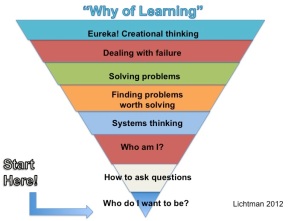In his post “The Immeasurable, Pt. 2” Will Richardson posted this great graphic to articulate the problem with assessment:
He states, correctly, of course, that we spend most of our time in the bottom left quadrant, and little in the upper right quadrant.
I think this is an issue that goes well beyond assessment, or better stated, starts well before assessment. Here are a number of reasons we focus on the bottom left corner:
- Comfort: This is where the adults grew up. We know this region of learning. Humans do not move out of comfortable environments unless forced to do so by some stress factor that is large relative to the inertia of comfort.
- Resource allocation: Education ships-of-state spend money and energy on content delivery. Our financial and operating models are built to support the lower left corner. Shifting these models to work in the upper right is going to be tough work that challenges well-entrenched interests, including our own, and those of people who are our friends.
- Politics: We love objective data that support political arguments related to student achievement. Objective data live in the lower left quadrant; it is the measurable framework of the industrial model.
- Fear: Moving resources up and to the right involves risk, and educators are risk averse.
- Mindset: as I posted a while back, we need to flip our Bloom-focused learning pathway to align with what so many of us feel is the better learning path, which starts in the upper right, not the bottom left.
6. Oh, yes, and assessment!: Given all of the above, we have not developed widely accepted assessment tools yet in the upper right areas.
The solution, of course, is to get out of our comfort zones, reallocate resources, thumb our nose at the politics, overcome our fears, flip our learning focus, and use the incredible brain power we have in the collective educational community to write and adopt new assessment tools, even if they aren’t perfect to start. Clearly this is not an assessment problem, it is a problem of institutional will. The combined good and bad news (depending on how willing you are to embrace change) is that, like global warming, we really don’t have any choice in the matter at this point. The environment is changing at a rapid pace and we either re-orient to the upper right corner or risk irrelevancy.



Great post, Grant. Part of the problem is we teachers. Most teachers, and I include myself in this description, were not gifted learners; we were bright learners. The distinction is important. Bright learners answer the questions, memorize well, and pay attention. They’re often teacher pleasers because the teacher receives affirmation from these students. Gifted learners question the answers, are good at guessing, can often be inattentive but focus when they care. They often feel stifled and bored by school. Your first reason for why we focus on the bottom left quadrant of Will’s diagram is comfort. I don’t think that’s where ALL the adults grew up. I think many adults got left behind there. But we teachers call the quadrant home because that’s where we experienced success. Last year I sat in on a presentation by Tony Wagner. An English department chair, a very bright man with a PhD, asked Tony, “The model we’ve been using worked for me growing up. What’s all that wrong with it?” Tony answered that that model develops teachers, not innovators. Seems to me we need to figure out how to develop, guide, and sustain teacher innovators.
Thanks, Holly. You just solved a problem for me: I guess I have always been gifted but not very bright! So maybe that is my contribution for the future: helping those who are a lot brighter than I am ask the right questions.
Am following the back chat at Michael Fullan’s and Douglas Reeve’s presentation at #SAICONF12. Reeves cites a recent study that shows submissive, least creative kids are ones most popular with teachers. Most creative kids least popular. I’d like access to that study. I’ve suspected that was true, but would like to read the findings.
[…] The Precursors of Messy Assessment « The Learning Pond […]
[…] http://learningpond.wordpress.com/2012/08/07/the-precursors-of-messy-assessment/ Share this:TwitterFacebookLike this:LikeBe the first to like this. Bookmark the permalink. Leave a comment […]